
Ipswich is a city in South East Queensland, Australia. Situated on the Bremer River, it is approximately 40 kilometres (25 mi) west of the Brisbane central business district. The city is renowned for its architectural, natural and cultural heritage. Ipswich preserves and operates from many of its historical buildings, with more than 6000 heritage-listed sites and over 500 parks. Ipswich was founded in 1827 as a mining settlement.
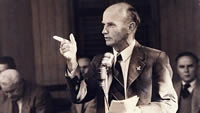
Frederick Woolnough Paterson was an Australian politician, activist, unionist and lawyer. He is the only representative of the Communist Party of Australia to be elected to an Australian parliament.
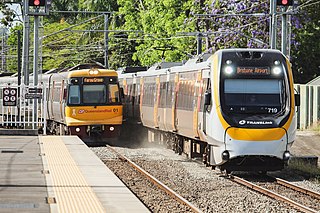
Queensland Rail (QR) is a railway operator in Queensland, Australia. Owned by the Queensland Government, it operates local and long-distance passenger services, as well as owning and maintaining rolling stock and approximately 6,600 kilometres (4,101 mi) of track and related infrastructure.
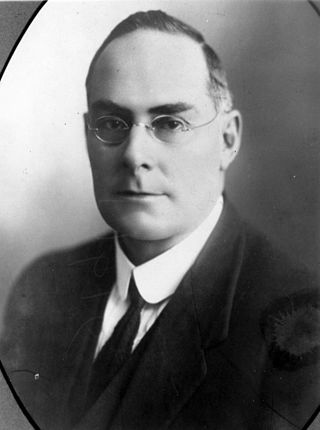
William McCormack was Premier of Queensland, Australia, from 1925 to 1929.

Edward Michael Hanlon was an Australian politician and soldier, who was Premier of Queensland from 1946 until his death in 1952.
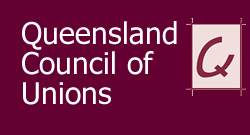
The Queensland Council of Unions (QCU) is a representative, an advocacy group, or peak body, of Queensland trade union organisations, also known as a labour council, in the Queensland, Australia. As of 2020, 26 unions and 13 regional branches were affiliated with the QCU. The QCU represents unions covering around 350,000 Queensland workers. It is affiliated with the Australian Council of Trade Unions (ACTU). Its offices are located in the suburb of South Brisbane, Queensland. As a peak body for the Queensland trade unions, the objective of the QCU is to achieve industrial, social and political justice for Queensland workers. The management structure of the QCU is made up of a committee of management and an executive of representatives comprised from affiliated unions.
The history of Queensland encompasses both a long Aboriginal Australian presence as well as the more recent periods of European colonisation and as a state of Australia. Before being charted and claimed for the Kingdom of Great Britain by Lieutenant James Cook in 1770, the coast of north-eastern Australia was explored by Dutch and French navigators. Queensland separated from the Colony of New South Wales as a self-governing Crown colony in 1859. In 1901 it became one of the six founding states of Australia.
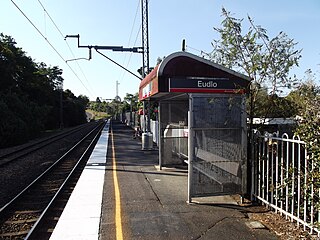
Eudlo railway station is located on the North Coast line in Queensland, Australia. It serves the town of Eudlo in the Sunshine Coast Region. It is one of few stations that can only fit 4 carriages onto the platform.

The Tree of Knowledge was a heritage-listed tree in Oak Street, Barcaldine, Barcaldine Region, Queensland, Australia, that was poisoned and killed in 2006. It was a 200-year-old Corymbia aparrerinja ghost gum. It was added to the Queensland Heritage Register on 21 October 1992.

Kilkivan is a town and locality in the Gympie Region of Queensland, Australia. At the 2016 census, Kilkivan had a population of 713.

Wooroolin is a rural town and a locality in the South Burnett Region, Queensland, Australia.

Gilbert Stephen Casey was a trade unionist, agitator of the early Australian labour movement and a utopian socialist.

The Beaudesert Shire Tramway was a narrow gauge tramway which operated from Beaudesert to Lamington and Rathdowney in the Scenic Rim Region, Queensland, Australia, It was one of 15 light railways built and operated by Divisional Boards and Shire Councils in Queensland. The line carried passengers and cargo. It operated from 1903 to 1944. It was initially profitable and seen as a great success for the local shire council. The tramway is credited with opening up the agricultural lands of the upper Logan River.
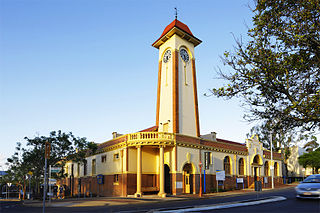
The Town of Sandgate is a former local government area of Queensland, Australia, located in northern Brisbane adjacent to Moreton Bay.

David Alexander Gledson was an accountant and member of the Queensland Legislative Assembly.

John Dash was a member of the Queensland Legislative Assembly.
The National Union of Rail Workers of Australia (NUR) was an Australian trade union representing railway industry workers which operated from 1938 until 1993.
Turbot Street runs parallel to Ann Street and is on the northern side of the Brisbane CBD in Queensland, Australia. It is a major thoroughfare, linking as a three-to-five lane one-way street with the Riverside Expressway in the southwest to the suburb of Fortitude Valley in the northeast; address numbers run the same direction. It is a one-way pair with Ann Street.
Mount Lawless is a rural locality in the North Burnett Region, Queensland, Australia. In the 2016 census, Mount Lawless had a population of 12 people.

Patrick Short was a police officer who served as the Commissioner of the Queensland Police Force from 1921 until his retirement in 1925. He was the first Queensland-born police commissioner.
















